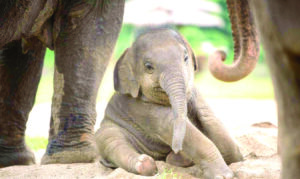By Dr. Beth Leermakers
They say a mother’s work is never done. As is true for human mothers, some animal mothers’ jobs are harder and more time consuming than others. As Mother’s Day approaches, test your knowledge about what motherhood looks like for a few animal species.

1) What mammal has the longest gestation period (pregnancy)?
A. Giraffe
B. Sperm Whale
C. Camel
D. African Elephant
E. Donkey
2) What mammal has the shortest gestation period?
A. Hamster
B. Virginia opossum
C. Meadow Mouse
D. Muskrat
3) The duration of gestation has adapted to meet the needs of each species. Which of these is a factor in the gestation period?
A. Size of the animal
B. Availability of food
C. Where they live
D. All of the above
E. None of the above
4) True or False. Embryos of some species (weasels, badgers) experience an arrest in development that greatly prolongs gestation.
5) What bird lays the largest eggs?
A. Emu
B. Ostrich
C. Cassawary
D. Emperor Penguin
E. Trumpeter Swan
6. What bird only lays one egg per year?
A. Emperor penguin
B. Laysan Albatross
C. Mourning Dove
D. A and B
E. A, B and C
7. True or False. The male seahorse gets pregnant and gives birth.
8. True or False. The orangutan stays with its mother longer than any other animal.
Answers:
1. D. African elephants are pregnant for 22 months (645 days). Elephants are highly intelligent creatures that are born that way. Developing their brain (the largest of any land animal, and three times larger than the human brain!) takes time. Elephants breastfeed their babies for two or three years. These other mammals are also on the top 10 (longest gestation) list: Sperm whale (480-590 days), giraffe (420-450), donkey (365), and camel (360-420).
2. B. Opossum mothers are pregnant for only 12 days. Born blind and naked and weighing about 0.0046 ounce apiece, the tiny, larvalike babies (an average of 7 per litter) crawl up to reach their mother’s fur-lined pouch. Each pouch young remains firmly attached to a nipple for its first 50–55 days. Then, the young either travel in the pouch or cling to the fur of their mother’s back until they are weaned and independent. Other mammals with short pregnancies include hamsters (20 days), meadow mice (21 days) and muskrats (29 days).
3. D. Smaller animals usually have shorter gestation periods than larger ones. In many species with restricted breeding seasons, gestation is adjusted so birth coincides with the period when food is most abundant. Horses, spring breeders with 11 months’ gestation, have their foals the following spring when grass is plentiful. Animals that live in the open (like horses) tend to have longer gestations and bear young that are more physically mature/developed (e.g., able to walk right away) than do animals (such as bears) that can hide their young in underground burrows or caves.
4. True. European badger embryos develop for a few days, then lie dormant in the uterus from July or August until the following January. They are born in March.
5. B. The ostrich (the largest bird in the world) lays the largest egg (weighing up to 4.5 lbs. and measuring 6 inches long and 5 inches in diameter). Ostrich eggs are relatively small (less than 2 percent) compared to the size and weight of their mother. In order, the next largest eggs are those of the Cassawary (1.4 lbs.), Emu (1-1.4 lbs.), Emperor Penguin (1-1.5 lbs.) and Trumpeter Swan (11.3 oz., the largest eggs of any flying bird).
6. D. Emperor penguins and Laysan Albatrosses lay only one egg per year. The male penguin takes the egg from the female (without letting it touch the icy ground) and incubates it on his feet for about 65 days. He doesn’t eat during that entire incubation period. Meanwhile the female goes out to sea to rejuvenate (spa vacation!). Mourning doves lay two eggs per clutch and can have five or six broods per season.
7. True. Seahorse females have it easy. The guys do all the work, incubating their developing embryos in a pouch (similar to a uterus) located on their tail. Scientists don’t know why the males carry the young, but one theory is that the female is free to produce the next batch of eggs while the male is pregnant.
8. True. Orangutan moms keep giving and giving. Orangutan babies nurse until they are six years old! The orangutan baby depends on its mother for so long because there is so much for the baby to learn to survive. Apparently learning to find his own food is way down the list!
Happy Mother’s Day to all the moms (of human and fur-kids)!
